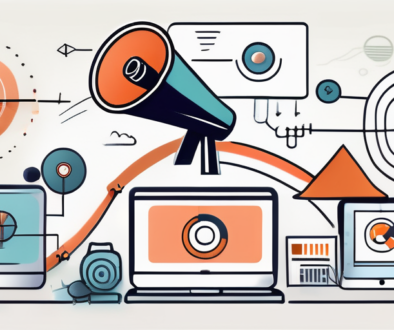Top B2B Landing Page Examples for Inspiration
B2B landing pages play a crucial role in the success of a business’s marketing efforts. These pages are specifically designed to capture leads and convert them into customers. In today’s competitive digital landscape, it is essential to create landing pages that stand out and drive results. To help you get inspired and create impactful B2B landing pages, we have compiled a list of top examples that showcase different strategies and design principles.
Understanding the Importance of B2B Landing Pages
Before we dive into the examples, let’s first understand why B2B landing pages are so important. Landing pages act as the gateway to your sales funnel, capturing the attention of potential clients and guiding them towards taking the desired action. They are specifically designed to provide relevant information and encourage visitors to take the next step, such as filling out a form or requesting a demo.
When it comes to B2B marketing strategies, landing pages play a crucial role in driving conversions and nurturing leads. These pages are meticulously crafted to cater to the specific needs and interests of business clients, offering tailored solutions and valuable insights that resonate with their professional requirements. By focusing on a targeted approach, B2B landing pages can effectively address pain points and showcase the unique selling propositions of a product or service.
The Role of Landing Pages in B2B Marketing
In B2B marketing, landing pages serve as an essential tool to generate leads and move prospects further down the sales funnel. Unlike a homepage or a generic web page, a landing page is focused on a single objective. It eliminates distractions and provides a clear call to action, resulting in higher conversion rates.
Moreover, B2B landing pages are instrumental in establishing credibility and trust with potential clients. By offering in-depth insights, case studies, and testimonials, these pages demonstrate expertise and industry knowledge, positioning the business as a reliable partner in addressing the needs of other businesses. This trust-building aspect is vital in B2B relationships, where long-term partnerships are often based on mutual respect and understanding.
Key Elements of a Successful B2B Landing Page
A successful B2B landing page comprises several key elements that work together to maximize conversions. These elements include a compelling headline, a concise yet persuasive copy, attention-grabbing visuals, a clear call to action, and social proof. By incorporating these elements strategically, you can create a landing page that captures attention and compels visitors to take the desired action.
Furthermore, personalization is becoming increasingly important in B2B marketing, and this extends to landing pages as well. Tailoring the content and messaging based on the specific industry, company size, or pain points of the target audience can significantly enhance the effectiveness of a landing page. By addressing the unique challenges faced by different businesses, personalized landing pages can establish a deeper connection and resonate more strongly with potential clients, driving higher engagement and conversion rates.
Analyzing High-Performing B2B Landing Pages
Now that we understand the importance of B2B landing pages let’s analyze some high-performing examples to gain insights and inspiration for our own campaigns.
When diving into the realm of high-performing B2B landing pages, it’s crucial to pay attention to the intricate details that set them apart. These pages are not just a collection of words and images; they are meticulously crafted digital assets designed to capture the attention of potential leads and guide them towards conversion. From the strategic placement of elements to the color schemes chosen to evoke specific emotions, every aspect plays a vital role in the overall success of these pages.
What Makes a B2B Landing Page Effective?
Effective B2B landing pages have a precise focus and cater to the needs of the target audience. They convey a clear value proposition and offer a solution to a pain point. These landing pages are visually appealing, well-structured, and provide relevant information without overwhelming the visitor. Additionally, they make it easy for visitors to take action by placing prominent and persuasive call-to-action buttons.
Moreover, the journey of a visitor on a B2B landing page is carefully mapped out, ensuring that every step they take is intentional and guides them closer to the desired outcome. From the initial headline that grabs attention to the supporting copy that builds interest and trust, each element works in harmony to create a seamless user experience. By understanding the psychology behind user behavior and decision-making, these high-performing landing pages are able to anticipate and address potential objections, making the path to conversion as smooth as possible.
Common Traits of Top B2B Landing Pages
While each B2B landing page is unique in its approach, there are several common traits that top-performing pages share. These traits include concise and persuasive headlines, benefit-oriented copy, eye-catching visuals or videos, trust symbols such as testimonials or case studies, mobile responsiveness, and optimized loading speed. Incorporating these traits in your own landing pages can significantly improve their effectiveness.
Furthermore, the use of data and analytics plays a crucial role in the ongoing optimization of B2B landing pages. By tracking user behavior, conducting A/B tests, and analyzing conversion rates, marketers can fine-tune every element of a landing page to maximize its performance. This iterative approach to design and content creation ensures that high-performing B2B landing pages are constantly evolving to meet the changing needs and preferences of the target audience.
Design Principles for B2B Landing Pages
The design of a landing page plays a crucial role in capturing and retaining the attention of visitors. Let’s explore some design principles that can help create impactful B2B landing pages.
The Power of Visuals in B2B Landing Pages
Visuals are a powerful tool for conveying messages and evoking emotions. Incorporating relevant and high-quality visuals such as images, infographics, or videos can enhance the overall aesthetics of your landing page. These visuals should support the key message and help the visitor visualize the benefits of your product or service.
When selecting visuals for your B2B landing page, it’s essential to ensure that they are not only visually appealing but also relevant to your target audience. Consider using images that showcase your product in real-world scenarios or infographics that highlight key statistics or benefits. Videos can also be a compelling addition, providing a dynamic way to engage visitors and communicate complex information in a digestible format.
Typography and Layout Considerations
The typography and layout of a landing page can significantly impact its readability and user experience. Choose fonts that are easy to read and align with your brand’s personality. Additionally, consider the layout of the page, ensuring that important elements are prominently displayed and that the overall structure is intuitive and visually appealing.
When it comes to typography, striking a balance between creativity and readability is key. Experiment with font sizes, styles, and spacing to create a visually engaging hierarchy that guides visitors through the content. In terms of layout, consider utilizing white space effectively to prevent overcrowding and allow important elements to stand out. A well-structured layout not only enhances the visual appeal of your B2B landing page but also improves navigation and overall user experience.
Copywriting Techniques for B2B Landing Pages
Well-crafted copy is essential for engaging visitors and persuading them to take action. Here are some effective copywriting techniques for your B2B landing pages.
When it comes to B2B landing pages, the art of copywriting plays a crucial role in capturing the attention of your target audience. Crafting compelling headlines and calls-to-action (CTAs) is a fundamental step in the process. Your headline serves as the first impression, so it’s vital to make it attention-grabbing and informative. By clearly articulating your unique value proposition and sparking curiosity, you can draw visitors in and encourage them to explore further.
Crafting Compelling Headlines and CTAs
The headline is the first element visitors see on your landing page, making it crucial for capturing attention. Craft headlines that clearly communicate the unique value proposition of your offering and evoke curiosity. Likewise, create compelling call-to-action (CTA) buttons that entice visitors to take the desired action. Keep the language clear, concise, and action-oriented.
Moreover, the effectiveness of your CTAs cannot be overstated. These buttons serve as prompts for visitors to take specific actions, such as signing up for a demo or downloading a whitepaper. By using persuasive language and creating a sense of urgency, you can increase the likelihood of conversion. Remember to place your CTAs strategically throughout the page to guide visitors seamlessly through the conversion funnel.
Writing Persuasive Body Copy
The body copy of your landing page should provide more detailed information about your product or service, addressing pain points and benefits. Write in a persuasive and customer-centric manner, focusing on how your offering can solve their problems. Break the copy into digestible paragraphs and use bullet points or numbered lists to highlight key features or benefits.
Furthermore, the body copy presents an opportunity to establish a connection with your audience by addressing their specific needs and demonstrating empathy. By showcasing real-world examples, testimonials, or case studies, you can build credibility and trust with potential customers. Remember to maintain a consistent tone throughout the copy and align it with your brand voice to reinforce brand identity.
Conversion Optimization Strategies for B2B Landing Pages
Conversion optimization is a continuous process that involves testing and refining your landing pages to maximize their effectiveness. Here are some strategies you can employ.
When it comes to B2B landing pages, one crucial aspect to consider is the alignment between your ad copy and landing page content. Ensuring a seamless transition from the ad to the landing page can significantly impact conversion rates. By maintaining consistency in messaging and design elements, you can build trust with visitors and increase the likelihood of conversions.
Importance of A/B Testing in Conversion Optimization
A/B testing involves creating multiple versions of your landing page and testing them against each other to determine which one performs better. This allows you to identify elements that can be improved, such as headlines, visuals, or CTAs. By conducting A/B tests, you can make data-driven decisions and optimize your landing pages for higher conversions.
Furthermore, personalization is key in B2B marketing. Tailoring your landing page content to address the specific needs and pain points of your target audience can significantly impact conversion rates. By leveraging data and insights to create personalized experiences, you can enhance engagement and drive conversions.
Utilizing Analytics for Landing Page Improvement
Analytics provide valuable insights into visitor behavior and can help identify areas of improvement for your landing pages. Analyze metrics such as bounce rate, time on page, and conversion rate to gain a better understanding of how visitors interact with your landing pages. Use this data to optimize your pages and make them more appealing and persuasive.
By studying these top B2B landing page examples and understanding the fundamental principles of effective landing page design, you can create your own high-performing landing pages that drive conversions and boost your business’s success in the B2B market.



